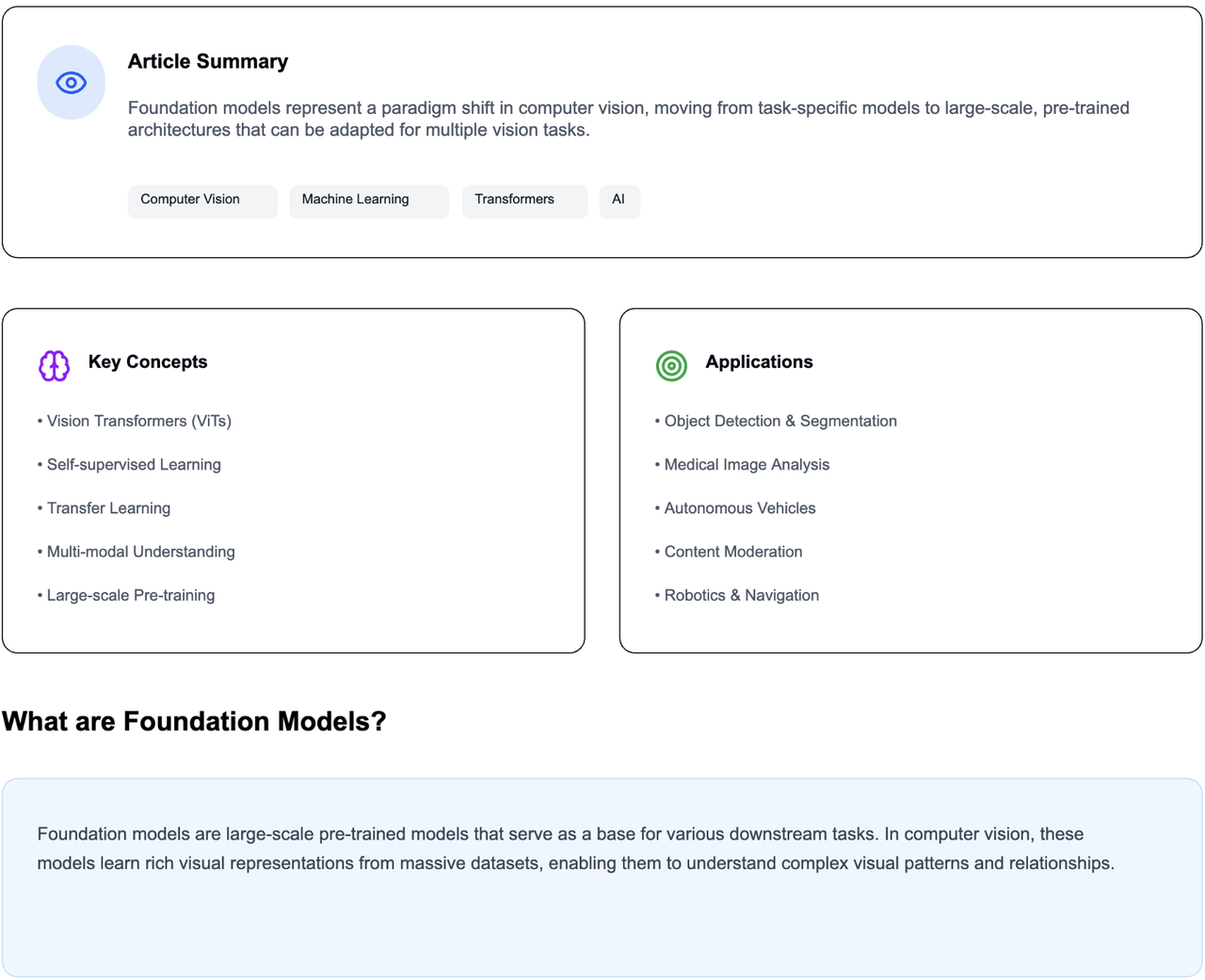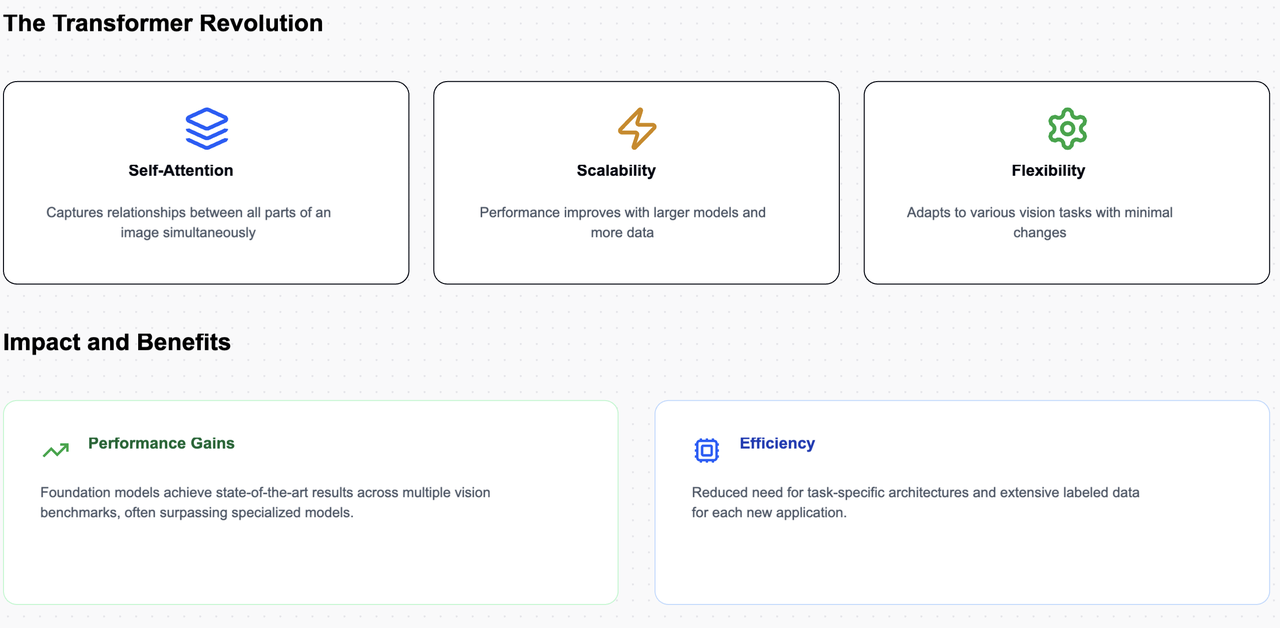
Introduction: The Vision Revolution¶
The goal of enabling computers to perceive the world as humans do—recognizing objects, understanding scenes, and processing complex visual information in fractions of a second—has been a long-standing pursuit in computer vision research. Foundation models are significantly advancing this objective.
Foundation models in computer vision signify a shift from traditional methodologies. Rather than developing distinct models for individual tasks, these robust systems learn from extensive visual datasets and can be applied across various domains, including medical diagnostics and autonomous vehicles.
Definition of Vision Foundation Models¶
Vision foundation models are large-scale AI systems trained on extensive datasets comprising images and visual data. Unlike conventional computer vision models that rely on meticulously labeled data for each task, these models utilize self-supervised learning, enabling them to identify patterns in unannotated visual data.
Key Characteristics:¶
- Scale: Trained on millions to billions of images
- Versatility: Adaptable to various vision tasks
- Self-supervised learning: Minimizes reliance on manual annotations
- Multimodal integration: Merges visual data with text, audio, and other inputs
Core Capabilities of Vision Foundation Models¶
1. Semantic Understanding Tasks¶
These models excel in interpreting visual content:
Examples:
- Image Classification: Identifying objects such as cats, dogs, or cars
- Object Detection: Locating and labeling multiple objects in a single image
- Scene Understanding: Recognizing scenarios like "busy street corner" or "peaceful forest"
- Action Recognition: Identifying actions in videos, such as "running" or "cooking"
2. Geometric and 3D Understanding¶
Foundation models can analyze spatial relationships and three-dimensional structures:
Examples:
- Depth Estimation: Assessing the distance of objects from the camera
- 3D Reconstruction: Creating 3D models from 2D images
- Motion Tracking: Monitoring the movement of objects over time
3. Multimodal Integration¶
These systems integrate visual data with various other data types:
Examples:
- Visual Question Answering: Responding to questions like "How many people are in this photo?" by analyzing the image
- Image Captioning: Producing descriptive text such as "A golden retriever playing in a sunny park"
- Text-to-Image Generation: Creating visuals from descriptions like "a futuristic city at sunset"
Real-World Applications Transforming Industries¶
Healthcare Revolution¶
Foundation models are enhancing diagnostic capabilities:
- Medical Imaging: Identifying early-stage cancers in X-rays and MRIs with exceptional accuracy.
- Surgical Assistance: Offering real-time guidance during intricate procedures.
- Patient Monitoring: Analyzing video feeds to promptly detect falls or medical emergencies in healthcare settings.
Autonomous Transportation¶
Self-driving technology is heavily dependent on vision foundation models:
- Environmental Perception: Interpreting road conditions, traffic signs, and pedestrian actions.
- Obstacle Detection: Real-time identification and avoidance of hazards.
- Navigation: Safely planning routes through complex urban landscapes.
Creative Industries¶
These models are transforming content creation:
- Film and Animation: Streamlining visual effects and crafting realistic digital environments.
- Photography: Enhancing images and producing artistic effects.
- Advertising: Creating tailored visuals for marketing initiatives.
Smart Home Technology¶
Ambient intelligence driven by foundation models:
- Activity Recognition: Analyzing daily routines to enhance home automation.
- Security Systems: Differentiating between family members, visitors, and potential threats.
- Elderly Care: Monitoring for falls or unusual behavior patterns.

Current Limitations and Challenges¶
1. Compositional Understanding¶
Challenge: While these models excel at recognizing individual objects, they struggle with complex compositions. For instance, they may identify "red" and "bicycle" but fail to comprehend "red bicycle next to blue car" in atypical arrangements.
2. Computational Efficiency¶
Challenge: High-resolution video processing demands significant computational resources. A single 1080p video frame contains over 2 million pixels, making real-time processing of extensive video footage highly resource-intensive.
3. Physical Understanding¶
Challenge: Existing models lack a comprehensive grasp of physics and cause-and-effect relationships. For example, a model may depict a person "floating" in mid-air without recognizing this contradicts physical laws.
4. Evaluation Difficulties¶
Challenge: Assessing the quality and accuracy of generated content remains a challenge. Traditional metrics often fail to align with human judgment, complicating the evaluation of true model performance.
The Technology Behind the Magic¶
Self-Supervised Learning¶
Foundation models utilize puzzle-solving tasks to learn without extensive labeled data:
- Masked Image Modeling: Predicting missing image segments.
- Contrastive Learning: Differentiating between similar and distinct images.
- Cross-modal Learning: Aligning images with corresponding text descriptions.
Architecture Innovations¶
Vision Transformers: These architectures, adapted from natural language processing, process images as sequences of patches, enhancing understanding.
Multimodal Architectures: Systems that simultaneously analyze images, text, audio, and other data types for a comprehensive understanding.
Future Horizons and Emerging Possibilities¶
Enhanced Reasoning Capabilities¶
Future models will improve in understanding:
- Temporal Relationships: The sequence of events in videos.
- Causal Understanding: The relationship between actions and outcomes.
- Common Sense Reasoning: Logical inferences in everyday contexts.
Embodied Intelligence¶
Robotic integration will enable:
- Interactive Learning: Learning through physical interaction.
- Real-time Adaptation: Adjusting understanding based on immediate feedback.
- Social Intelligence: Interpreting human emotions and social cues.
Democratized AI Tools¶
Enhancing accessibility to advanced vision capabilities:
- No-code Platforms: Empowering non-developers to create custom applications.
- Edge Computing: Implementing models on smartphones and IoT devices.
- Personalized Experiences: Adapting to individual user preferences.
Addressing Ethical Considerations¶
Bias and Fairness¶
Challenge: Models may reflect societal biases from training data. Solutions: Utilize diverse datasets, bias detection tools, and inclusive development teams.
Privacy and Surveillance¶
Challenge: Advanced systems raise privacy concerns. Solutions: Implement privacy-preserving techniques, establish clear policies, and develop regulatory frameworks.
Misinformation and Deepfakes¶
Challenge: Advanced capabilities may generate misleading content. Solutions: Create detection tools, employ digital watermarking, and promote media literacy.
Getting Started: Practical Next Steps¶
For Developers¶
- Explore Open-Source Models: Utilize pre-trained models like CLIP or DALL-E.
- Learn Transfer Learning: Adapt foundation models for specific applications.
- Practice with APIs: Engage with cloud-based vision services to explore functionalities.
For Businesses¶
- Identify Use Cases: Explore areas where vision AI can enhance operations.
- Start Small: Initiate pilot projects to gauge potential and constraints.
- Build Expertise: Train teams or collaborate with AI specialists.
For Researchers¶
- Focus on Gaps: Address limitations in compositional understanding.
- Interdisciplinary Collaboration: Merge computer vision with psychology, neuroscience, and other disciplines.
- Ethical Research: Emphasize responsible development and deployment.

Conclusion: A New Era of Machine Vision¶
Foundation models signify a paradigm shift in artificial intelligence and its societal implications. By leveraging extensive visual data, these systems are acquiring remarkable capabilities that can revolutionize industries, enhance human potential, and address complex challenges.
The path forward presents vast opportunities alongside significant hurdles. Striking a balance between innovation and responsibility is essential to ensure these advanced tools serve humanity while mitigating risks.
The future of computer vision transcends mere machine perception; it aims to foster intelligent systems capable of understanding, reasoning, and engaging with the visual world in ways that augment human abilities. We are at the forefront of this transformative journey.
Citation: Bommasani, R., Hudson, D. A., Adeli, E., Altman, R., Arora, S., von Arx, S., ... & Liang, P. (2022). On the opportunities and risks of foundation models. arXiv preprint arXiv:2108.07258. Available at: https://arxiv.org/abs/2108.07258